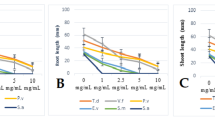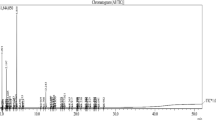Abstract
The effect of crude volatile oils from the leaves ofEucalyptus globulus andE. citriodora and the pure terpenes - cineole and limonene from these oils, (in vapour form) was studied onPhaseolus aureus, Lens esculentum, Hordeum vulgare and Avena sativa. The parameters like germination of seeds, seedling growth, values of cell survival, and content of water and chlorophyll of the crops formed the system of bioefficacy study. The allelopathic impact of the oil vapours from the eucalypt tree becomes evident from the negative response of the parameters studied. The impact of the E. citriodora oil vapours compared to that ofE. globulus oil or the pure terpenes was seen to be relatively greater in almost all parameters under investigation. A strong reciprocal correlation that exist between the concentration and the seedling growth or the water content of the crops under study supports the dose linked allelopathic phenomenon. It is suggested that oil vapours ofEucalyptus exert their effect through impairing the respiratory as well as photosynthetic ability of the target plants.
Similar content being viewed by others
Reference
Al-Mousawi, A. H., Al-Naib, F. A. G.: Allelopathic effects ofEucalyptus microtheca F. Muell. - J. Univ. Kuwait, Sci.2:59–66, 1975.
Al-Mousawi, A. H., Al-Naib, F. A. G.: Volatile growth inhibitors produced byEucalyptus microtheca - Bull. Biol. Res. Cent7:17–23, 1976.
Al-Naib, A., Al-Mousawi, A. H.: Allelopathic effects ofEucalyptus microtheca: Identification and characterisation of the phenolic inEucalyptus microtheca. - J. Univ. Kuwait, Sci.3:83–87, 1976.
Baker, H. G.: Volatile growth inhibitors produced byEucalyptus globulus. - Madrono18:207–210, 1966.
Bhaskar, V., Dasappa: Ground flora in Eucalyptus plantation of different ages. - In: Sharma, J. K., Nair, C. T. S., Kedharnath S., Konda, S. (ed.):Eucalyptus in India: Past, Present and Future. Pp. 213–224. KFRI Publ., Kerala 1986.
Del Moral, R., Muller, G. H.: The allelopathic effects ofEucalyptus camaldulensis. - Amer. Midl. Nat. 83:254–282, 1970.
Duncan, D. B.: Multiple range and multiple F-test. - Biometrics11:1–48, 1955.
Hiscox, T. D., Israelstam, G. F.: A method for extraction of chlorophyll from leaf tissue without maceration. - Can. J. Bot.57:1332–1334, 1979.
International Seed Testing Association: International rules for seed testing. - Seed Sci. Technol.4:1–180, 1976.
Kohli, R. K.:Eucalyptus - an antisocial tree for social forestry. - In: Khosla, P.K., Kohli, R. K., (ed.): Social Forestry for Rural Develoment. Pp. 235–241. ISTS Publ., Solan 1987.
Kohli, R. K., Kaur, K., Choudhary, P., Kumari, A., Saxena, D. B.: Negative aspects ofEucalyptus farming. - In: Khurana, D. K., Khosla, P. K. (ed.): Agroforestry for Rural Needs. Vol. 1. Pp. 225–233. ISTS Publ. 1987.
Kumari, A., Kohli, R. K., Saxena, D. B.: Allelopathic effect ofParthenium hysterophorus L. leachates and extracts on Brassica campestris L. - Ann. Biol.1:189–196, 1985.
Lovett, J. V.: Allelopathy and self defence in plants. - Aust. Weeds2:33–36, 1982.
Lovett, J. V.: Defensive strategies of plants, with special reference to allelopathy. - Pap. Proc. roy Soc. Tasmania119:31–37, 1985.
Muller, C. H.: The role of chemical inhibition (allelopathy) in vegetational composition. - Bull. Torrey bot. Club93:332–351, 1966.
Muller, W. H., Muller, C. H.: Volatile growth inhibitors produced by Salvia species. - Bull. Torrey bot. Club91:327–330, 1964.
Polová, M., Vicherková, M.: Leaf diffusibility changes on bean and sunflower plants treated with essential oil vapours - Scr. Fac. Sci. nat. Univ. Purkynianae Brunensis16:119–128, 1986.
Putnam, A. R.: Allelochemicals: Blessing or courses for agriculture. - Agr. Food Chem.1:183–206, 1988.
Steponkus, P. L., Lanphear, F. O.: Refinement of the triphenyl tetrazolium chloride method of determining cold injury. -Plant Physiol.42:1423–1426, 1967.
Trease, G. E., Evans, W. C: Text Book of Pharmacognosy. Pp. 200–213. Bailliere, Tindall, London 1983.
Vicherková, M., Polová, M.: Effect of essential oil vapours of different concentrations upon leaf transpiration of bean and sunflower. - Scr. Fac. Sci. nat. Univ. Purkynianae Brunensis16:109–118, 1986.
Author information
Authors and Affiliations
Rights and permissions
About this article
Cite this article
Kohli, R.K., Singh, D. Allelopathic impact of volatile components fromEucalyptus on crop plants. Biol Plant 33, 475–483 (1991). https://doi.org/10.1007/BF02897723
Received:
Accepted:
Issue Date:
DOI: https://doi.org/10.1007/BF02897723




